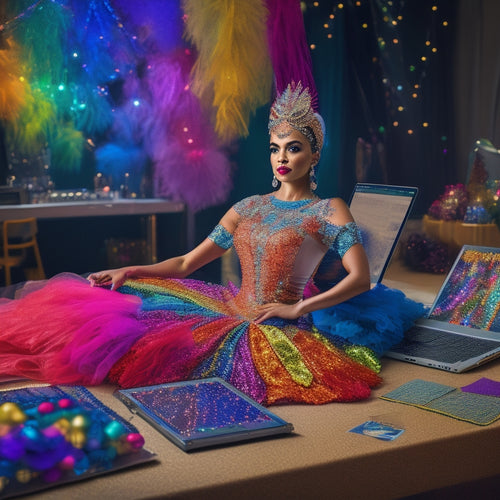
Empowering Dance: Celebrating Women, Psychology Insights
Share
Empowering dance is a powerful catalyst for celebrating women's contributions to the art form, fostering a deeper understanding of the psychological intricacies that drive performance excellence and holistic growth. By recognizing and promoting female pioneers in dance, we can break down traditional gender norms and pave the way for future generations to shine. By embracing psychology insights, dancers can overcome performance anxiety, cultivate a growth mindset, and tap into their full potential. As we celebrate women in dance, we uncover the transformative power of education, self-expression, and personal growth, leading us further down a path of discovery and empowerment.
Key Takeaways
• Celebrating women in dance breaks down barriers, challenging traditional gender norms and paving the way for future generations to shine.
• Delving into dance psychology helps tap into full performance potential by cultivating a deeper understanding of physical movement and mental preparedness.
• Empowering dance education recognizes the transformative power of education in shaping artistic expression and personal growth, promoting female representation and inclusivity.
• Developing a growth mindset and practicing self-compassion can help dancers overcome performance anxiety and optimize mental preparation.
• Integrating mindfulness practices into daily training fosters a deeper mind-body connection, enhancing emotional expression and overall performance.
Celebrating Women in Dance
Empowering women dancers to take center stage, the dance community celebrates the remarkable contributions of female dancers who have paved the way for future generations to shine.
Female pioneers in dance have broken down barriers, challenging traditional gender norms and stereotypes. Their trailblazing efforts have led to increased gender representation in the dance industry, inspiring a new wave of female dancers to take center stage.
Psychology Insights for Dancers
By delving into the intricacies of dance psychology, dancers can tap into the full potential of their performance, cultivating a deeper understanding of the complex interplay between physical movement and mental preparedness. This synergy enables dancers to overcome performance anxiety and optimize their mental preparation.
-
Develop a growth mindset to reframe challenges as opportunities for growth and improvement
-
Practice self-compassion to mitigate self-criticism and build confidence
-
Engage in mindfulness exercises to quiet the mind and focus on the present moment
Empowering Dance Education
As dancers cultivate a deeper understanding of the psychological aspects of their craft, they can begin to recognize the transformative power of education in shaping their artistic expression and personal growth.
Empowering dance education is vital in promoting female representation and educational empowerment. By fostering inclusive learning environments, we can encourage young dancers to explore their full potential. This involves providing access to resources, mentorship, and role models that celebrate women's contributions to the dance community.
Educational empowerment enables dancers to develop a strong sense of self, confidence, and resilience, ultimately leading to a more authentic and expressive performance. By investing in empowering dance education, we can inspire a new generation of female dancers to take center stage.
Dance Performance Enhancement
Through deliberate practice and a deep understanding of psychological principles, dancers can harness their full potential and elevate their performance to new heights. By honing performance techniques and mental preparation, dancers can refine their craft and overcome performance anxiety.
-
Develop emotional expression through authentic movement analysis, allowing dancers to tap into their inner selves and convey emotion through movement.
-
Cultivate a growth mindset, embracing challenges as opportunities for growth and improvement.
-
Integrate mindfulness practices into daily training, fostering a deeper connection between body and mind.
Frequently Asked Questions
How Can I Incorporate Dance Psychology Into My Teaching Practices?
To incorporate dance psychology into your teaching practices, cultivate mindful observation of students' emotional expression, fostering a safe space for exploration and self-awareness, and guide them to harness their emotional intelligence for authentic performance.
What Are Effective Strategies for Choreographing for Diverse Dance Styles?
"Juxtaposing traditional techniques with innovative approaches, effective strategies for choreographing diverse dance styles involve cultural fusion, rhythmic experimentation, and sensitivity to diverse body types, fostering an inclusive and dynamic creative process."
Can Dance Education Courses Be Adapted for Students With Disabilities?
By incorporating accessible choreography and inclusive curriculum, dance education courses can be adapted to empower students with disabilities, fostering a holistic learning environment that values diversity, promotes equality, and celebrates individuality.
How Do I Create a Safe and Inclusive Dance Community for All Students?
As a tapestry of diverse threads, a safe and inclusive dance community is woven by embracing body positivity, cultural sensitivity, and empathy, where every student's unique rhythm is valued, and differences are celebrated, fostering a harmonious dance floor.
What Are Some Tips for Maintaining Physical and Mental Well-Being as a Dancer?
"Cultivate body awareness through mindfulness practices, acknowledging physical and emotional limits. Prioritize self-care, embracing rest and recovery as essential to maintaining physical and mental well-being as a dancer, fostering a culture of holistic self-awareness."
Related Posts
-

Design Stunning Dance Costumes With Online Tutorials
With online tutorials, you're just a click away from accessing stunning dance costumes that mesmerize the audience. D...
-

3 Pro Tips to Overcome Makeup Task Procrastination
You're stuck in a never-ending cycle of makeup task procrastination, feeling overwhelmed by the complexity of the tas...
-

Groove in Your Kitchen With Digital Download
With a digital download, you can instantly transform your kitchen into a vibrant space that reflects your personal st...


